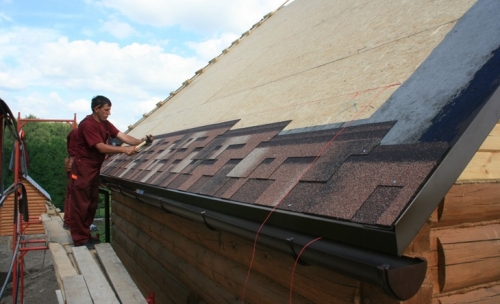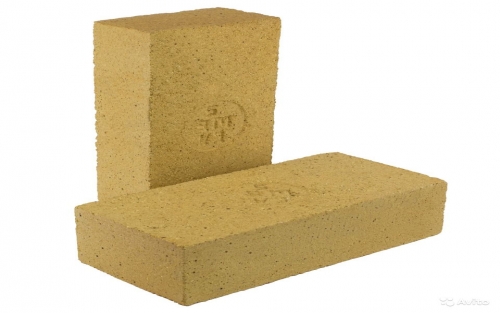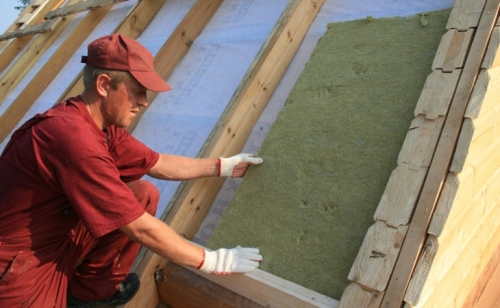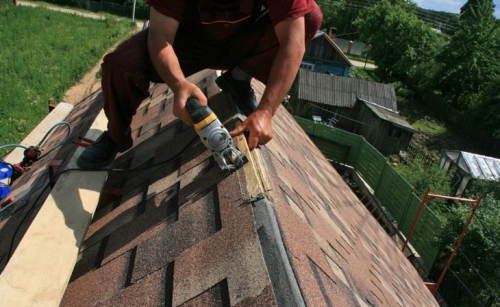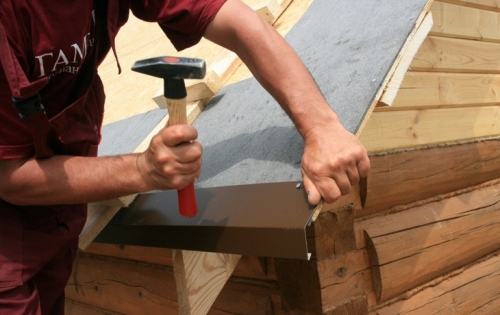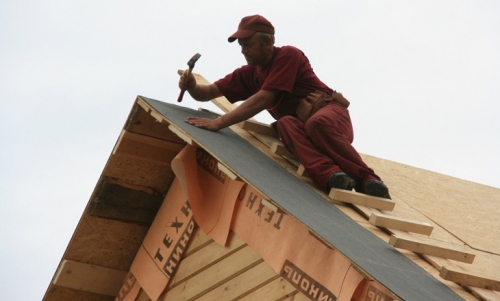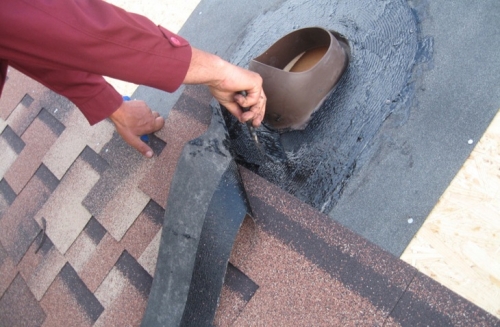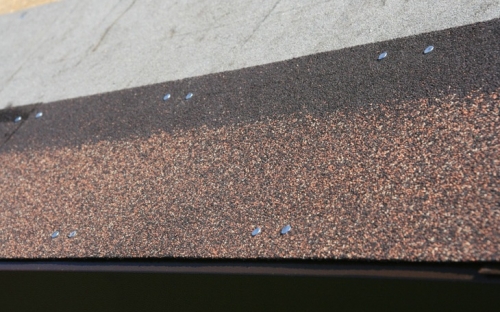The most popular base that is mounted in commercial and residential buildings ...
|
|
Liquid wallpaper quickly broke into the market of finishing materials and also rapidly ... |
If you are a beginner master and do not have sufficient experience in construction ... |
How to cover the roof with soft tiles
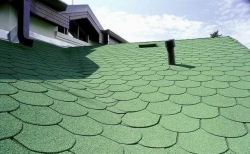
Surely, you have repeatedly noticed that many private houses are covered with flexible tiles, noble, solid and aesthetically attractive roofing material. You can equip such a roof, because you can lay this coating on a roof of any complexity, the slope of which reaches 12 - 90 degrees. Bitumen is very light, which facilitates the installation of a soft roof with your own hands. Today we will talk about how to cover the roof with soft tiles.
Content:
- Calculation of bitumen tiles
- Installation of the crate under the roof
- Installation of the lining layer
- The device of the ventilation space
- Installation of soft tiles
- Proper design of junctions
- The procedure for sealing joints
Calculation of bitumen tiles
Before buying soft tiles, it must be taken into account that the price of a soft roof will depend on the area of \u200b\u200bthe coating and the number of additional elements. A feature of the material used to organize the roof is minimizing waste during work. It is this factor that allows you to accurately calculate the roof and calculate the required amount of the main material.
We give an example of calculating the amount of flexible tiles. So, let the gable roof have the following parameters: the length is 6 meters, the height is 4 meters; The angle of inclination is 32 degrees. Then the total area is 48 square meters (4*6*2). Keep in mind that one flexible tile packaging is enough for 3 meters of square. But be careful, since each package indicates the covered area. Then you will need 16 packages (48/3).
Similarly, you can calculate the amount of the required lining material and the apple carpet. It should be noted that the technology of roof covering with soft tiles is such that cut parts and waste will always remain. Therefore, feel free to add another 10-15%to the calculated amount. After buying a soft tile, it is necessary to store it in a warm dry place, folding one by one not more than 12 packs.
Installation of the crate under the roof
To lay the bitumen tile correctly, it is necessary to correctly prepare the base. The soft roof can be laid on an ordinary crate, which is of a lattice or continuous and attached to the rafters. The frame is most often made of wood. If you need to arrange a lattice crate, then take the boards for this.
At the same time, it is desirable to use chopped boards from coniferous breed, which have a thickness of 20-25 millimeters close. To create a solid crate, you can use a moisture -resistant plywood or chipboard, diluted and trimming boards. The moisture content of the material should not be more than 20% of dry weight. The material is attached to the rafters using ordinary nails or screws.

To increase the time of the service of wooden elements, they must be impregnated with an antiseptic until the moment of installation. When creating the crate, calculate the steps installation step and the thickness of the board used for its device. If the step is 60 centimeters, then you can use a board, which has a thickness of 20 millimeters. With a step of rafters of 90 centimeters, a board is required with a thickness of approximately 23 millimeters.
The joints of the boards must be placed in the places of the supports, and the boards should have a length of at least 2 spans between the supports. With the flooring of the crate under the soft roof, it is necessary to remember that it is worth leaving a couple of millimeters between individual materials in order to compensate for the process of expanding the wood when drying out.
On the crate between the boards, a gap of 1-5 millimeters is made, between large -length elements of 1 - 3 millimeters. Plywood and plates on the rafters are laid with the run of the seams. You may not leave such gaps if all the wood was pre -prone to technical drying.
Installation of the lining layer
After arranging the crate under the soft roof, you need to lay the lining layer, the main purpose of which lies in protecting the house on moisture when possible flexible tile leaks. According to the current standards, if the angle of inclination of the roof is 18 degrees and a little larger, then waterproofing can only be equipped with a parallel by the end and eaves. It is these sites that are considered the most likely places of leaks.
Things will be different if the roof has a smaller angle of slope - from 12 to 18 degrees. The installation technology of such a waterproofing layer provides for its laying over the entire area of \u200b\u200bthe roof. This layer is mounted parallel to the cornice over the bottom with the bottom with an overlap at least 10 centimeters for transverse seams and at least 15 centimeters for longitudinal ones, fixing the edges with nails with an interval of 20 centimeters. The seams are necessarily sealed with glue.
To protect the edges of the frame structure of the roof under the soft tiles on the cornice overhangs from moisture, you need to mount metal cornice strips under the name droppers with an overlap of at least 2 centimeters on top of the lining carpet. They are nailed with a zigzago with special roofing nails, withstanding a step of 100 millimeters. To protect the crate on the end parts, the front -line strips with the same overlap of 2 centimeters are mounted. They fill the bar on cornices and ends over the lining layer.
If the design has elements such as the valleys, then it is necessary to lay a special carpet that corresponds to the color of the tiles, on both sides. The edges should be fixed with roofing nails, withstanding the interval of 100 millimeters. It will not be superfluous after fixing to smear the carpet along the edge of the bitumen mastic.
The device of the ventilation space
Without sufficient ventilation in the attic, the microclimate, humidity and condensation will increase. Ventilation is provided thanks to three elements: channels over thermal insulation, hole, which serves for the flow of outdoor air and exhaust holes that are located in the upper part of the roof.
If the cornices in a residential building are fucked by siding, then sophimity planks will be a ventilation gap.
If, when placing a roof under a soft roof, the cornice is decorated with lining, then it is customary to equip a gap between the boards. Roof ventilation from flexible tiles is performed at the expense of the skate, which is customary to lay on a special ribbed profile. But often there is not enough its throughput and you need to install special ventilation elements on the surface of the roof.
If the slope of the roof is 15 - 40 degrees, then the area of \u200b\u200bthe ventilation space is calculated as a private total area of \u200b\u200bthe slopes and the coefficient of 300. And if the slope reaches 41 - 85 degrees, then it is calculated as a private area of \u200b\u200bthe soft roof and coefficient 600. Let the total area of \u200b\u200bthe roof is 50 square meters, the angle of inclination is 35 degrees, and the cross section of the ventilation element is 258 square centimeters.
The ventilation area in this case will be 0.167 square meters (50/300) or 1670 centimeters of square. Then the required amount of ventilation elements is five (1670/258). The number of ventilation elements that are installed on the horse is half their number on the slope of the roof, that is 3.
Installation of soft tiles
Flexible tile manufacturers do not recommend fixing it at a temperature below plus 5 degrees, because the races in the cold become fragile and the procedure for the roof of the roof made of soft tiles is difficult, and the lack of heat affects the tightness of the compounds. In winter, the joints and bends of the racing should be heated with a construction hairdryer or other device that forms the heat flux. To lay the material on the roof in the summer, it must be taken in parts, because the protective film is removed from the tiles heated by the sun.
When laying tiles, roofers often make the same mistake, as a result of which the roof has a different shade in different places. Remember that the tiles in different packages may not be from one batch, but from different ones, and therefore its color differs. Thus, it is necessary to immediately use several packages of the material so that the color of the roof is uniform.
To simplify the work and provide even lines before covering the roof with soft tiles on the roof, chalk marking of the slope is carried out along the crate and lining. Horizontal lines are drawn parallel to the cornice overhang with a step of 80 centimeters. It turns out approximately 5 rows of tiles. Vertical lines are applied along the length of the slope with a step of 1 meter.
Installation of roofs from flexible tiles begin with the arrangement of a zero cornice row. A self-adhesive skate-carnious tile is glued over a metal bar. From the edge of the slope you need to retreat 1-2 centimeters. The tiles on the other hand are nailed with nails, and the first row of ordinary flexible tiles is laid in the place of fastening. If you have not bought a skate-carnis tile, you can attach to the cornice and simple hounds, but without petals.
The first row of a private flexible tile begins to be laid from the center of the cornice, heading for the ridge and pediments. To move in hot weather on the roof, you need to use special blades, otherwise traces of shoes may remain on the roofing. First, the protective film on the back is removed from separate roofing tiles and glue them to the base. Also, the tile requires additional fastening.
The tiles are attached with nails, scoring them when laying two neighboring rows. When you score a nail in the first row, then you will kill the second at the same time. You can’t shift the fastening of the nail from the very edge or to the center of the petals, since the device of the roof of soft tiles does not allow chaotic fastening, you can not praise the nail so that the hat is located at the same level with the roofing.
Approximately 4-5 nails are spent on one gunt. This is enough, since the bitumen tile among themselves under the influence of solar heat itself glues and sticks to the crate. The length of the nails is selected for the type and thickness of the crate. The diameter of the nail should be approximately 3.2 millimeters, the diameter of the hat is 10 millimeters.
When installing the subsequent rows of tiles, remember that the lower petals of the material must correspond to the upper ones, which are located on the already nailed row. Along with this, it is customary to make a shift of half a petal left or right.
The skating tile is obtained if you divide the cornice tiles into three parts by perforation. Monting the skating tile on the roof horse, after cutting the tiles, while the short side should be located in parallel to the skate. Beat four nails so that the nails are located under the superimposed tile with an overlap of 5 centimeters.
Proper design of junctions
In the process of installing a soft coating for the roof, it is often necessary to deal with some difficulties and various objects to which the roof adjoins. Say, the most elementary object of this type is the stove heating pipe. On the site where the pipe adjoins the roof, a gap along which moisture flows.
To get rid of this drawback, you need to correctly attach flexible tiles. To begin with, forget the rail on the corner between the surface of the roof and the chimney. It is desirable that it has a triangular shape, like an ordinary wooden baseboard. Next, it is recommended to make a tile on this rail and directly onto the pipe. After that, the carpet should be laid on top of it, starting from the chimney.
It should cover the entire channel at a height from the roof surface of 30 centimeters. After that, the lower part of the pipe with a carpet and bitumen tile is placed in a metal apron - from all sides it is covered with sheets of painted tin. To avoid accumulating the snow pipe, it is necessary to equip the m land by installing a pyramid with two faces to the pipe. Thus, both snow and rainwater will fall on the sluts of the fan and drain down the roof down, flowing out the pipe.
Sometimes, some communications need to be removed through the roof. In such cases, it is best to use passing elements that are made specifically for tiles. They are attached to the base of the roof with the help of nails. Such elements reliably protect the roof from leakage. For example, the antenna passages of a small diameter through the roof can be performed with rubber seals.
The procedure for sealing joints
For sealing the roof of soft tiles, overlapping carpets and ordinary bitumen tiles on the apple carpet, passages of the ventilation system and various adjacents use a special sealant. Immediately before applying the composition, clean the surface of bulk materials, oil and dirt. Apply a bitumen solution to the dusty and porous foundations. Remember that with an excess of glue, maybe excessive dissolution of bitumen will occur.
The composition is applied to one of the glued surfaces with a spatula. Maintain a layer thickness of 0.5 - 1 millimeter. The width of the gluing is indicated in the instructions. When gluing adjacents to the pipes and walls, apply sealant over the entire surface of contact. Get the seams of brickwork with a solution with a brick with a solution. The gluing process lasts 1-3 minutes, depending on the air temperature. At low temperatures before application, the composition must be heated.
Now you know how to cover the roof with soft tiles! In addition, you can always update the roof with flexible tiles without removing the old coating. Laying over the old new soft tile is not very different from the laying process from scratch. To do this, put an inverted gunt on the protruding cornice strip and glue it, and cut the protruding part along the cornice. Next, the tile is laid exactly over the previous pattern.

